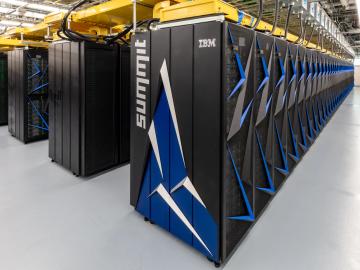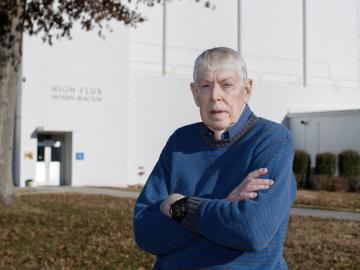
Filter News
Area of Research
- Advanced Manufacturing (13)
- Biological Systems (1)
- Biology and Environment (41)
- Building Technologies (2)
- Clean Energy (129)
- Climate and Environmental Systems (2)
- Computational Biology (1)
- Computational Engineering (3)
- Computer Science (12)
- Electricity and Smart Grid (1)
- Fusion and Fission (14)
- Fusion Energy (7)
- Isotopes (12)
- Materials (70)
- Materials for Computing (18)
- Mathematics (1)
- National Security (12)
- Neutron Science (39)
- Nuclear Science and Technology (12)
- Quantum information Science (6)
- Sensors and Controls (1)
- Supercomputing (52)
- Transportation Systems (2)
Date
News Topics
- 3-D Printing/Advanced Manufacturing (41)
- Advanced Reactors (9)
- Artificial Intelligence (19)
- Big Data (12)
- Bioenergy (22)
- Biology (23)
- Biomedical (15)
- Biotechnology (6)
- Buildings (13)
- Chemical Sciences (7)
- Clean Water (13)
- Climate Change (11)
- Composites (8)
- Computer Science (65)
- Coronavirus (10)
- Critical Materials (4)
- Cybersecurity (10)
- Decarbonization (7)
- Energy Storage (30)
- Environment (58)
- Exascale Computing (4)
- Frontier (6)
- Fusion (13)
- Grid (16)
- High-Performance Computing (19)
- Isotopes (13)
- ITER (4)
- Machine Learning (6)
- Materials (32)
- Materials Science (42)
- Mathematics (1)
- Mercury (4)
- Microscopy (15)
- Molten Salt (1)
- Nanotechnology (16)
- National Security (7)
- Net Zero (1)
- Neutron Science (36)
- Nuclear Energy (23)
- Physics (9)
- Polymers (7)
- Quantum Computing (5)
- Quantum Science (22)
- Security (5)
- Space Exploration (8)
- Statistics (1)
- Summit (18)
- Sustainable Energy (43)
- Transportation (33)
Media Contacts

Algorithms developed at Oak Ridge National Laboratory can greatly enhance X-ray computed tomography images of 3D-printed metal parts, resulting in more accurate, faster scans.

As Hurricane Dorian raged through the Bahamas, researchers at Oak Ridge National Laboratory worked around the clock to aid recovery efforts for one of the Caribbean’s worst storms ever.

As program manager for the Department of Energy’s Oak Ridge National Laboratory’s Package Testing Program, Oscar Martinez enjoys finding and fixing technical issues.

This round-up of ten of the most-read news stories from Oak Ridge National Laboratory in 2019 showcases the diversity of the lab’s scientific and engineering research portfolio.

George Flanagan, a nuclear engineer at the Department of Energy’s Oak Ridge National Laboratory, didn’t get to relax much between 1987 and 1990.

For nearly three decades, scientists and engineers across the globe have worked on the Square Kilometre Array (SKA), a project focused on designing and building the world’s largest radio telescope. Although the SKA will collect enormous amounts of precise astronomical data in record time, scientific breakthroughs will only be possible with systems able to efficiently process that data.

Gina Tourassi has been appointed as director of the National Center for Computational Sciences, a division of the Computing and Computational Sciences Directorate at Oak Ridge National Laboratory.
Ancient Greeks imagined that everything in the natural world came from their goddess Physis; her name is the source of the word physics.

Illustration of the optimized zeolite catalyst, or NbAlS-1, which enables a highly efficient chemical reaction to create butene, a renewable source of energy, without expending high amounts of energy for the conversion. Credit: Jill Hemman, Oak Ridge National Laboratory/U.S. Dept. of Energy

While Tsouris’ water research is diverse in scope, its fundamentals are based on basic science principles that remain largely unchanged, particularly in a mature field like chemical engineering.


